In B2B procurement, understanding terms like RFP, RFQ, and RFI is key to finding the right products and services for your business. Each of these tools plays a specific role in the process, helping you gather information, compare options, and make informed decisions. In this article, we’ll break down what RFQ (Request for Quote), RFP (Request for Proposal), and RFI (Request for Information) mean and how they’re used in the procurement workflow.
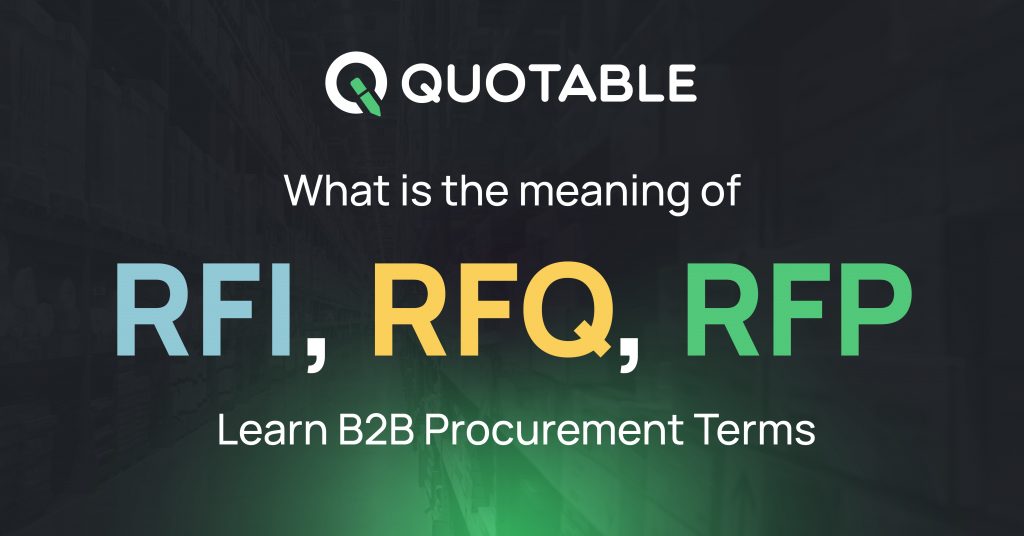
What is an RFI?
A Request for Information (RFI) is a document or process companies use to gather basic details about potential suppliers, including their products, services, and capabilities. Think of it as a preliminary step in evaluating whether a supplier might be a good fit for your business needs.
Is an RFI a contract?
An RFI is not a commitment or contract; it’s simply a way to collect information to help you make informed decisions later in the procurement process. For suppliers, responding to an RFI allows them to determine if their offerings align with what the requesting company needs.
When are RFIs used in Procurement?
RFIs are often the first step in a sequence that might lead to more detailed requests like RFQs (Request for Quotation) or RFPs (Request for Proposal), but it’s important to note that an RFI is purely for information-gathering purposes. It helps companies understand what’s available in the market before moving forward with more specific requests.
How does a Request for Information (RFI) work?
An RFI starts when a company’s procurement or supply chain management team creates a simple questionnaire. This form includes a brief intro about the company, what products or services they need, any specific requirements, and what information they want from potential suppliers.
What’s next after the RFI form?
After the RFI is ready, it’s sent to a group of suppliers who might be able to meet these needs. The supplier responds by a set deadline, letting the company know if they can provide what’s requested.
The process is easy and focuses on collecting basic information, helping the company figure out which suppliers to consider for the next steps.
Why Use an RFI in Procurement?
Organizations of various sizes use RFIs for several reasons including…
- Market Insight: RFIs provide valuable information about the products, services, and trends available in the market.
- Evaluating Suppliers: They help companies assess the skills and capabilities of different suppliers, making it easier to determine which ones might be suitable for future projects.
- Reducing Risks: RFIs allow companies to identify potential risks and challenges with specific products or services before committing to a purchase.
What are the Components of Using RFIs in Procurement?
- Overview and Goals: A brief summary of the company’s objectives and what the RFI aims to achieve.
- Details Required: Targeted questions to gather information on vendor capabilities, experience, products, services, pricing, and other relevant factors.
- Accuracy of Information: Instructions for suppliers on how to format and submit their responses, along with deadlines and contact information.
- Outlined Terms: Guidelines on specific payment terms and fulfillment information.
- Future Steps: An outline of what the company plans to do with the RFI responses, including any follow-up actions or next steps in the process.
Examples of Industries that Use RFI in Procurement
An RFI is especially helpful when a company is in the early stages of purchasing and needs to clarify its specific requirements for a service. While an RFI is often followed by an RFQ or RFP, some companies prefer to skip the RFI and go straight to an RFQ. However, others value the extra step of added due diligence in their procurement process.
For example, if a business is looking to outsource customer support and needs 50 agents, they might send out an RFI to identify potential BPO companies. This helps them narrow down their options and move smoothly into the RFQ process, knowing which suppliers can meet their needs and what services they offer.

What is an RFQ?
A Request for Quote (RFQ) is a document or process used by companies to gather detailed pricing information for a specific product or service. When a company knows exactly what it needs and in what quantity, it may skip the RFI stage and go straight to issuing an RFQ.
When are RFQs used in Procurement?
RFQs are often used for items that are common or standardized within an industry, where the main differentiating factors between suppliers are price, delivery times, and other straightforward considerations. Whether issued alone or before a Request for Proposal (RFP), an RFQ is typically used when the company has a clear understanding of what it needs and is ready to compare suppliers based on pricing and other specific criteria.
How do RFQs Work?
A Request for Quote (RFQ) focuses primarily on costs but also requires specific details from suppliers. When issuing an RFQ, a company will ask for:
- A description of the goods or services, including specifications
- Pricing details
- Quantities needed
- Delivery requirements
- Payment terms
- Evaluation criteria so suppliers understand how their bids will be evaluated
- Submission requirements and deadlines
Procurement teams often use templates for RFQs to ensure all suppliers respond in a similar format, making it easier to compare quotes efficiently. One great example of RFQs is Quotable, a FREE software that automates the entire RFQ workflow.
What Does a Digitized RFQ Look Like in Quotable?
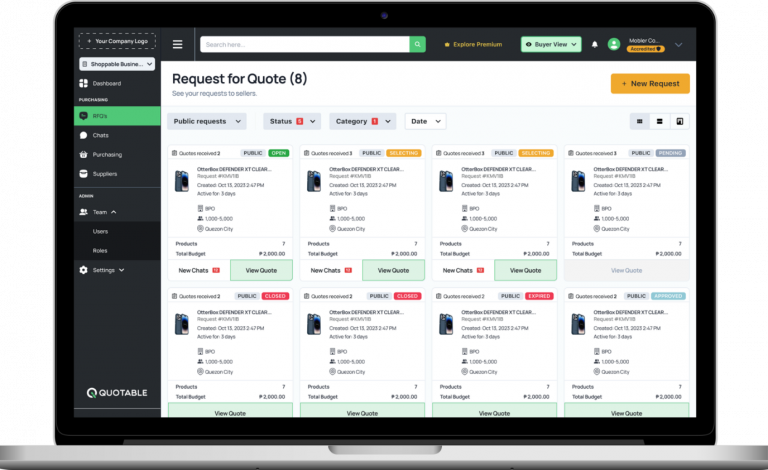
The RFQ process typically involves these six steps…
- Identify Requirements and Prepare the RFQ Document: Clearly define what is needed and create the RFQ.
- Select Potential Suppliers: Determine which suppliers should receive the RFQ.
- Send Out the RFQ: Distribute the RFQ to the chosen suppliers.
- Collect and Analyze Responses: Review the quotes submitted by suppliers, focusing on price and other critical factors.
- Negotiate and Award the Supplier: If needed, negotiate terms before selecting the supplier that offers the best value.
- Finalize the Contract and Begin Onboarding: Once a supplier is chosen, a contract is signed, and the supplier is onboarded.
In some cases, companies may run a live or e-auction during the RFQ process, especially if multiple suppliers submit similar bids. This auction could last 24 hours and aims to secure the best price.
After selecting the supplier with the most favorable bid, the company moves into the contract phase, ensuring the supplier meets the specified requirements.
Why use an RFQ in Procurement?
Organizations use RFQs in procurement for several key reasons:
- Efficient Price Comparison: RFQs simplify the workflow of gathering and comparing prices from multiple suppliers, making it easier to find the most cost-effective option.
- Clarity and Simplicity: Since RFQs focus on specific, well-defined requirements, they are straightforward, making them ideal when price is the main factor in the decision.
- Cost Savings: By requesting competitive quotes, organizations can negotiate better deals, helping them control costs effectively.
What are the Components of Using an RFQ in Procurement?
- Description of Goods or Services: A clear outline of what is needed, including relevant specifications or standards.
- Required Quantities: The exact amount of goods or services needed, along with any variations or special requirements.
- Pricing Details: Instructions for suppliers on how to present their pricing, including unit costs, total prices, and any discounts or special terms.
- Delivery Requirements: Specifics on delivery schedules, shipping methods, and associated costs or responsibilities.
- Terms and Conditions: The legal and contractual details, such as payment terms, warranties, and liability provisions, that will be used in the purchase.
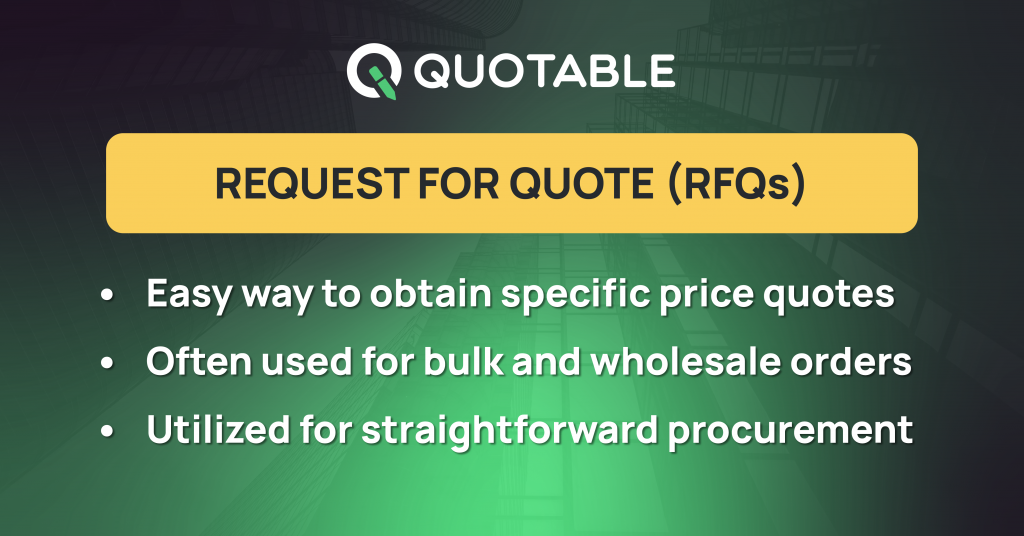
What is an RFP?
A Request for Proposal (RFP) is a document or process that a company uses to outline the details of a project and ask suppliers to submit bids. Unlike an RFQ, which mainly compares prices, an RFP looks at the overall value a supplier can provide, especially when the project is complex and involves multiple factors.
When are RFPs used in procurement?
RFPs are typically used for more complicated projects where the company needs to evaluate various options. For example, if a construction company needs to source different materials to build an infrastructure, the process is more intricate than just buying cement. An RFP helps the company get detailed proposals from suppliers that cover all aspects of the project.
What does an RFP contain?
An RFP usually includes a description of the work needed, a timeline for the project, how the bids will be evaluated, and the steps for selecting the supplier. Companies use RFPs to find the best supplier by considering multiple factors like cost, quality, delivery schedules, and even environmental impact.
How does RFP work in procurement?
The RFP process in procurement starts with the procurement, purchasing, or supply chain management team outlining the desired outcome and drafting a detailed request for proposal. This request typically includes several components:
- Cover Page: The introduction to the request.
- Company Overview and Scope of Work: A brief description of the company and the project’s goals, often referred to as the statement of work.
- Clear Requirements: A detailed list of what the company needs from the suppliers.
- Supplier Questionnaire: Specific questions suppliers need to answer to demonstrate their ability to meet the requirements.
- Instructions for Responding: Guidelines on how suppliers should complete the questionnaire to ensure consistency.
- Bidding and Evaluation Process: A description of how bids will be assessed and the criteria for selection.
- Submission Deadline: The final date by which suppliers must submit their proposals.
The paperless process…
The format in which suppliers respond is crucial. Traditionally, responses were gathered using spreadsheets, but these can be prone to errors and formatting issues. Suppliers might also submit their responses in different formats, making it challenging to compare them. This is one reason digitized procurement software is becoming more essential in the everyday procurement workflow. Quotable is a great example of a platform that serves this purpose, as it’s a paperless solution that automates the entire process.
What are the Benefits of Quotable in the Procurement Workflow?
- FREE for MSMEs
- Invite Existing or New Suppliers
- Get Live Quote Requests
- Compare Top Quotes
- Share for Approval
- Streamline Purchasing & Sales
- Add your Team to Manage
Why use an RFP in procurement?
RFPs encourage suppliers to come up with unique ideas. For instance, if a company is looking for steel, a supplier might propose an alternative material that’s just as strong but cheaper. This flexibility helps both the company and the supplier reach a beneficial agreement.
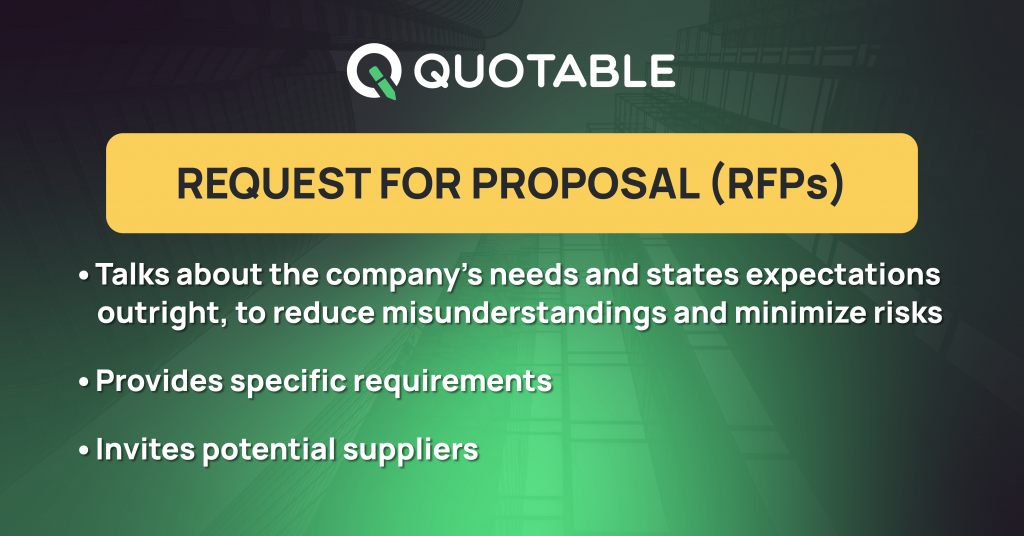
Traditional vs. Digitized RFI, RFQ, and RFP Processes
Traditional
Traditional methods like spreadsheets, emails, and phone calls can hinder a competitive bidding process. These manual tools don’t allow suppliers to see how their bids compare to others, and they lack a quick and efficient way to address questions during the process. For buyers, manually collecting, analyzing, and sharing bids with stakeholders can be time-consuming and prone to errors.
Digitized
Technology offers more efficient ways to handle procurement workflow. Advanced procurement software such as Quotable can automate the entire process, from designing the RFI, RFQ, or RFP event to collecting and analyzing supplier responses. This software enhances bidding transparency, allowing suppliers to see where they stand and enabling nearly real-time communication between buyers and suppliers.
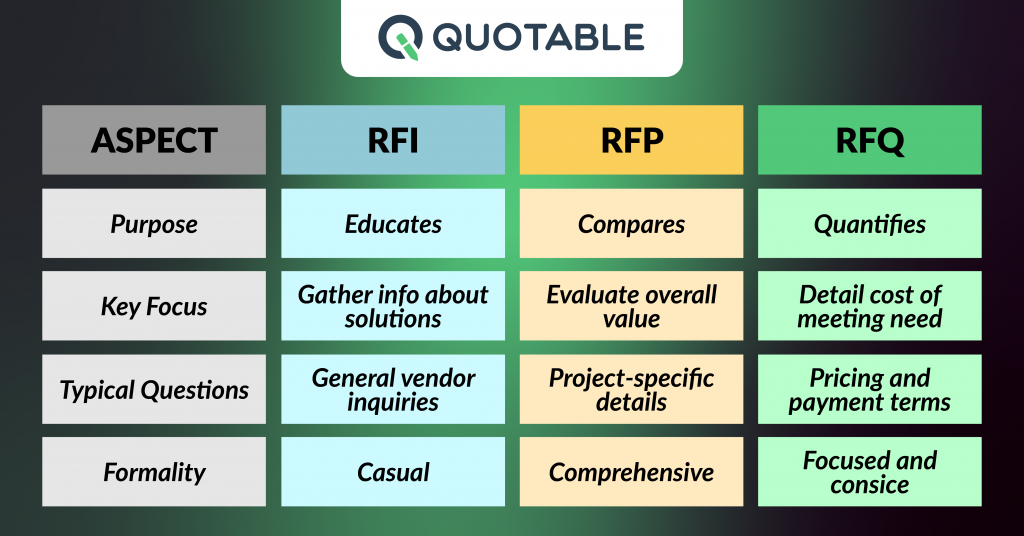
Main Points
Understanding and using RFPs, RFQs, and RFIs can make a big difference in how smoothly a business handles its procurement workflow. Knowing what each of these tools is for can make the buying process more efficient, build better relationships with suppliers, and get the most value out of their deals. Whether it’s getting detailed bids, comparing prices, or gathering market information, these tools help businesses make smart decisions.
RFI, RFQ, and RFP are important parts of a good procurement process. When you know how to use them, you can make sure everything is clear, find the best suppliers, and create strong partnerships. Using these tools correctly is key to making your procurement workflow successful. The next step is switching to a solution that empowers your business, like Quotable.
Simplify your procurement workflow with Shoppable’s newest tool, Quotable! This FREE and user-friendly software is designed for MSMEs in the Philippines.
See how Quotable can ease your business operations by visiting
